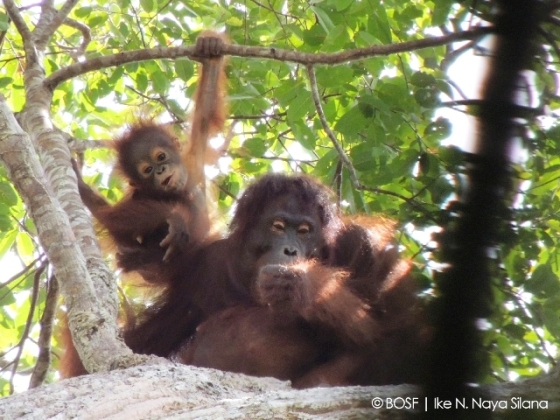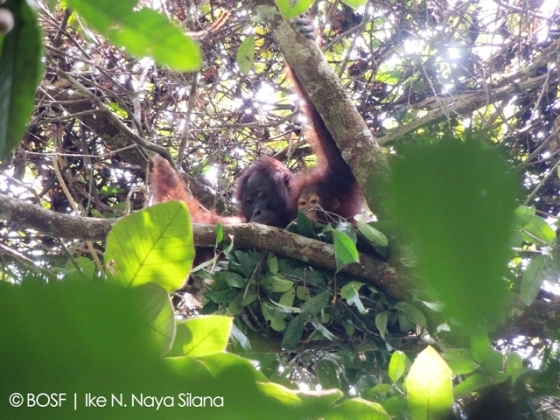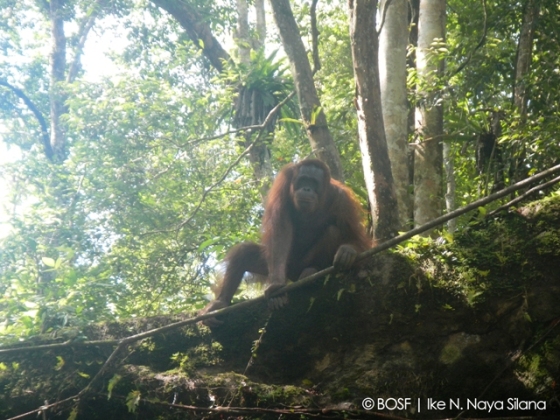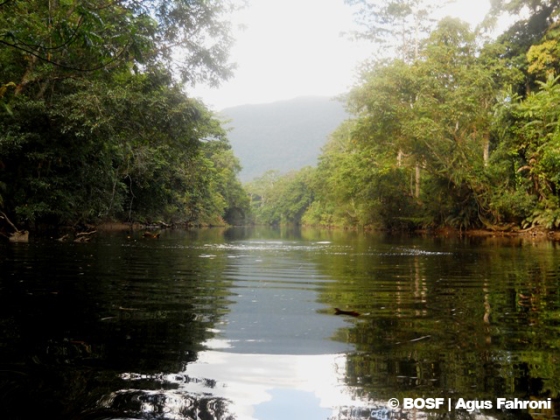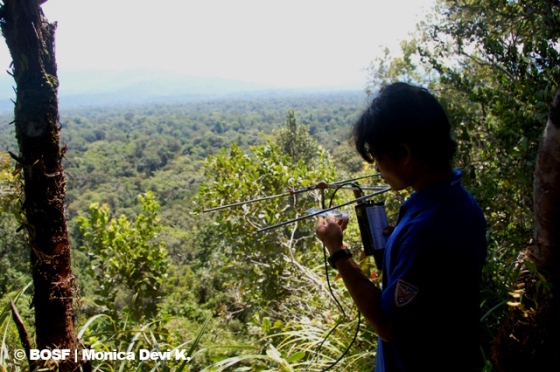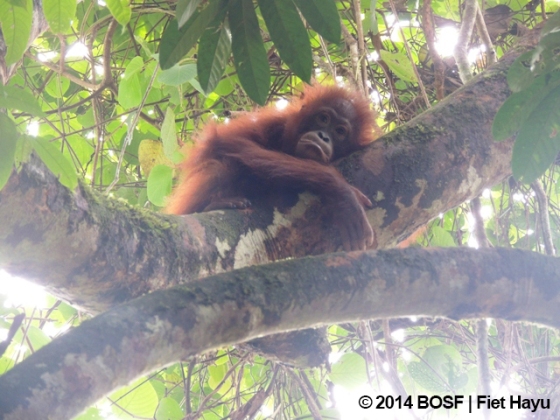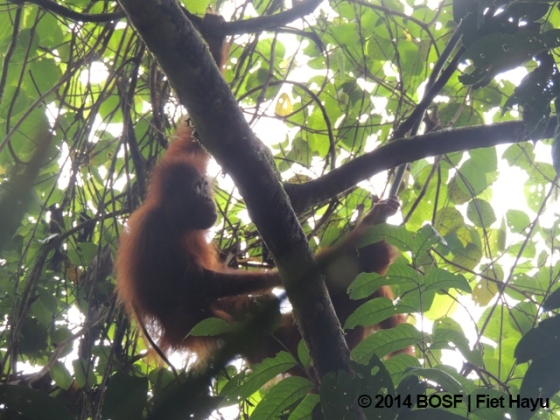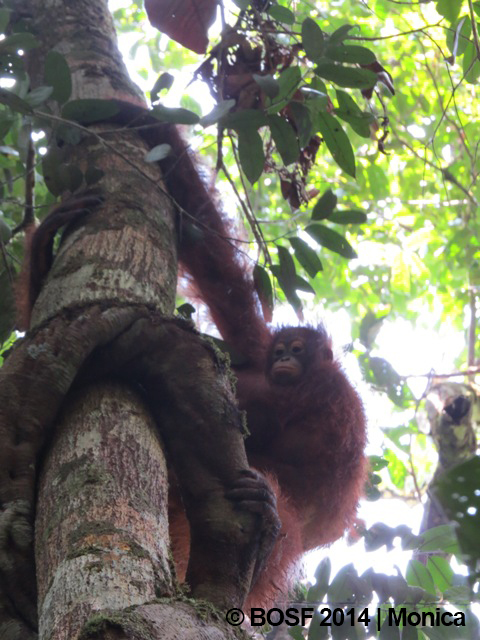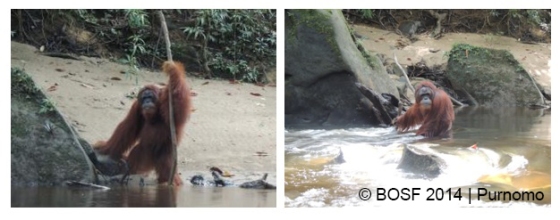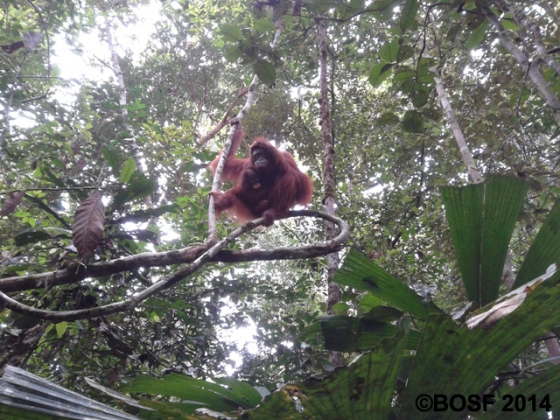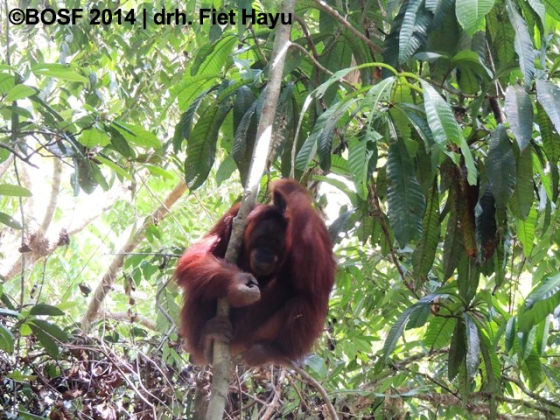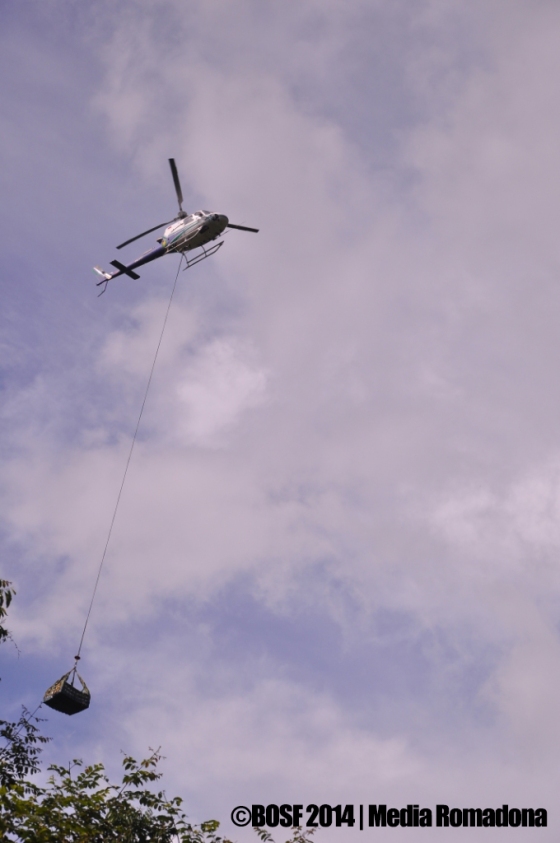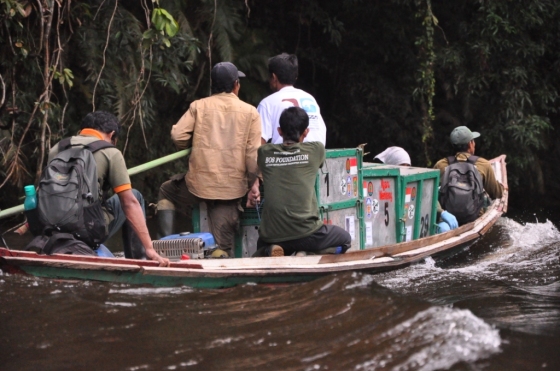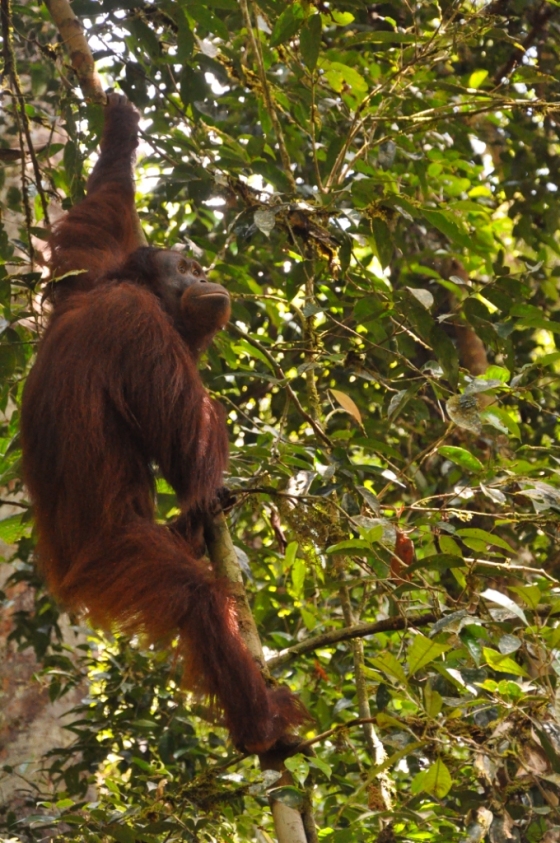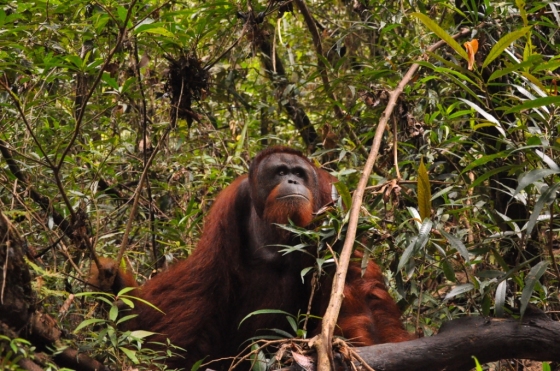In the near future, 12 more orangutans will be living in Bukit Batikap Conservation Forest. They are from Orangutan Reintroduction Center at Nyaru Menteng who will be reintroduced into the forest on April, 19 and 20 2014. Here are their profiles.
REHABILITANT
Rehabilitants are orangutans who were rescued at a very young age and/or had been kept by humans as pets. These orangutans did not have or had lost most of the necessary skills to survive independently in the forest and thus must go through an intensive rehabilitation process (Forest School and the final pre-release stage on an island/halfway forest), which can take up to 7 years on average.
1. SLAMET
Slamet arrived in Wanariset, East Kalimantan on January 23, 1999 after being confiscated from a resident of Palangka Raya who kept him as a pet. In November 1999, the BOS Foundation established an new Orangutan Reintroduction Program in Nyaru Menteng, Central Kalimantan and on December 17, 1999 Slamet entered Nyaru Menteng to continue his rehabilitation. On arrival in Nyaru Menteng, the then three year old male orangutan weighed 12 kilograms.
Having graduated from Forest School, Slamet continued his education on Palas Island for the last phase of the rehabilitation process in 2004. He has grown into an active dominant orangutan who dislikes human presence. He has dark brown long hair, dark skin and growing cheekpads.
Slamet is now 18 years old and weighs 65 kilograms. After 15 years of rehabilitation in Nyaru Menteng soon the dashing Slamet will explore his true home in the Bukit Batikap Conservation Forest.

2. KIKI
Kiki arrived in Nyaru Menteng on April 18, 2001 after being confiscated from a resident in Ketapang, West Kalimantan who kept her illegally as a pet. She was six years old and weighed 18.5 kilograms. Asides from being underweight, she also suffered from atrophy due to having spent her life in a narrow cage. She was not able to stand and always seemed scared. Every single day the Medical Team provided massage therapy to help recover her leg muscle function and to teach her how to climb trees.
Kiki graduated from the Forest School and moved to live on Palas Island in 2005. She is known as a friendly orangutan towards other orangutans and loves to explore. On October 24, 2006, she gave birth to her firstborn, a daughter named Hardi. Kiki and little Hardi were amongst the orangutans who starred in the documentary “Orangutan Island”, along with Bonita, Kacio and Mego.
Kiki is now 20 years old and weighs 61 kilograms. The mother with dark brown long hair is now ready to be an independent mother to her daughter. Kiki and Hardi are both ready to live as wild orangutans in the Bukit Batikap Conservation Forest.

3. HARDI
Hardi is the firstborn of orangutan Kiki, born on Palas Island on October 24, 2006. She grew up under her mother’s care to become an independent wild orangutan. Young Hardi and her Mother are two of the stars featured in the documentary “Orangutan Island”.
Due to her wild and very active nature, Hardi’s ability grew fast. She is intelligent in recognising natural foods, building nest and conducts most of her activities in the trees. Just like a normal wild orangutan, Hardi loves forest fruits and dislikes human presence. On Palas Island Hardi doesn’t socialise much with other orangutans. She only makes friends with female orangutans who have a gentle nature and avoids dominant male orangutans.
Now in her 8th year of age, agile Hardi weighs 26 kilograms and is ready to go home to the Bukit Batikap Conservation Forest with her mother to become an independent teenage orangutan.

4. KACIO
Kacio was confiscated from Banjar Baru, South Kalimantan when she was only three years old and weighed seven kilograms. The female orangutan with long, thick hair arrived in Nyaru Menteng on May 13, 2002, having lost her middle toe and little toe on her left foot due to a strike from a sharp tool.
Kacio who is skilled in looking for natural foods such as forest fruits, leaves and bark graduated from Forest School and continued her learning on Palas Island in 2006. With her gentle and friendly nature, she behaves nicely towards almost all other orangutans on the island. She is a close friends of Kiki, Olympia and Yasmine who are going to be released with her. The independent Kacio rarely comes to the feeding platform and she prefers to explore the forest instead. She was also one of the stars in the documentary “Orangutan Island”.
Now it has been 12 years since Kacio started her rehabilitation in Nyaru Menteng. Fifteen years old and weighing 56 kilograms, this beautiful orangutan with round eyes will soon go home to the Bukit Batikap Conservation Forest to become a true wild orangutan.

5. OLYMPIA
Olympia arrived in Nyaru Menteng on March 27, 2002 after being confiscated from a resident of Tumbang Samba, Katingan Regency. She was two years old, weighed only 7.5 kilograms and still retained her natural behaviour.
Before being prepared as a release candidate, Olympia learnt in Nursery Group and Forest School. She graduated in 2006 and moved to Palas Island. One of her good friends since Forest School, Kacio, will also be released with her this April.
Olympia is a gentle orangutan and friendly to other orangutans. Now she is 15 years old and weighs 53 kilograms. After 12 years of rehabilitation in Nyaru Menteng, the female orangutan who prefers forest fruit and natural foods will finally prove her abilities in the Bukit Batikap Conservation Forest.

6. TROLD
One year old Trold who weighed 4.8 kilograms arrived in Nyaru Menteng on February 28, 2002 after being confiscated from a resident of Tumbang Talaken, Gunung Mas Regency who was keeping her illegally as a pet. This young wild-born orangutan arrived with some wounds on his fingers and toes.
Graduating from the Forest School in 2006, Trold improved her survival skills on Palas Island. Trold who has thick hair on her neck is also famous for being an expert explorer and skillful in choosing natural foods. She is a friendly orangutan who loves socialising with other orangutans but is not keen on human presence.
Trold has been learning in Nyaru Menteng for 12 years. Now 14 years old and weighing 41 kilograms, pretty Trold is ready to live a new life as a true wild orangutan once again in the Bukit Batikap Conservation Forest.

7. BONITA
Bonita arrived in Nyaru Menteng after being confiscated from a resident in Tumbang Samba on January 11, 2003 when she was two years old and weighed 5.1 kilograms. This wild-born orangutan was then placed in our Nursery Group. Bonita learned at the Forest School and was a close friend of Saturnus, who unfortunately passed away from illness in 2011. Bonita graduated as a smart student and was then placed in Midway (Nyaru Menteng II). On December 9, 2006, Bonita was moved to Palas Island. In the documentary “Orangutan Island”, we can see that Bonita was often being disturbed by “The Bandit Boys”.
While living on the pre-release island, Bonita once went missing for more than two months. A search commenced throughout the island, but to no avail until one day she simply came back, as fit as a fiddle. Her natural abilities improved quickly. She is skillful in choosing natural foods such us young leaves and termites and loves socialising with other orangutans.
This beautiful orangutan with dark brown hair is now 14 years old and weighs 53 kilograms. The experience she has gathered during 11 years at the rehabilitation center will help her explore her true home in the Bukit Batikap Conservation Forest.

8. SELLA
Sella was confiscated by the Central Kalimantan Conservaton and Natural Resources Authority from a resident in Palangka Raya. She arrived in Nyaru Menteng on April 13, 2002, when she was three years old and weighed 11 kilograms.
She graduated from Forest School in 2005 and was placed on Palas Island. This orangutan with thick hair loves to socialise with other orangutans, but dislikes human presence. Her ability to search for natural foods has improved significantly. Sella is also a respected orangutan on Palas Island and she loves spending timelooking for termites.
Now she has beenthrough the rehabilitation process for 12 years. At the age of 15 and weighing 59 kilograms, this orangutan will soon depart for the Bukit Batikap Conservation Forest where she will live her new life as a true wild orangutan.

9. MISS OWEN
Miss Owen was confiscated from a resident in Pontianak, West Kalimantan. On November 29, 1998, this female orangutan arrived in Wanariset in East Kalimantan to undergo the rehabilitation process, because at that time Wanariset was the only orangutan rehabilitation center in Kalimantan. After Nyaru Menteng was established in November 1999, this Central Kalimantan orangutan was then transferred to Nyaru Menteng when she was two years old and weighed 6.5 kilograms on December 17, 1999 to continue her rehabilitation process.
Miss Owen joined the Forest School and is a good friend of Noor, the very first orangutan who arrived in Nyaru Menteng and who is now living in Bukit Batikap. Miss Owen graduated from forest school and entered Palas Island in 2004. On the pre-release island, Miss Owen was a friendly orangutan and easily made friends with other orangutans. The orangutan who sometimes looked like a loner used to be a good friend of Reno until he was released earlier into Bukit Batikap.
She has been undergoing the rehabilitaton process for 15 years and grown into an adult 17 year old orangutan weighing 40 kilograms. With the experience she has gained on Palas Island, Miss Owen is now ready to live in the Bukit Batikap Conservation Forest as a true wild orangutan.

10. OMEGO (MEGO)
Omego (Mego) was confiscated from Jakarta and arrived in Nyaru Menteng on May 31 2001, when he was three years old and weighed 8 kilograms. By the time he was confiscated, there were dried scabs on his front part of the body, thighs, and arm folds. After going through medical care to completely recover his skin condition, Mego with his brown thick hair was enrolled in the Forest School.
Mego who has round eyes graduated from Forest School and continued to the final pre-release stage in 2005 on Palas Island. Mego has grown into a dominant male orangutan with growing cheekpads.
The experience he has gained after 13 years of living in Nyaru Menteng is sufficient to help him survive in his natural habitat. Now a dashing 17 year old weighing 72 kilograms, he is ready to go home to become a true wild orangutan in his new home, theBukit Batikap Conservation Forest.

SEMI-WILD
Semi-wilds are orangutans who have still retained their true nature at the time of rescue and have consistently showed that they have learned adequate forest skills.
11. WARDAH
Wardah arrived in Nyaru Menteng on October 21, 2006 after being rescued by the Central Kalimantan Conservation and Natural Resources Authority and the BOS Foundation Rescue Team. She was rescued from a remaining small patch of forest in an oil palm plantation in East Kotawaringin Regency when she was three years old and weighed only 7 kg. Her mother was nowhere in sight.
Wardah is a semi-wild orangutan and has been prepared as an orangutan release candidate in Nyaru Menteng Quarantine Complex 3.
It has been eight years since she started the rehabilitation process in Nyaru Menteng and she still retains her wild behaviour. She is now 11 years old and weighs 43 kg. Soon she will enjoy her freedom in exploring the Bukit Batikap Conservation Forest to live as a true wild orangutan.

12. CUPLIS
Cuplis arrived in Nyaru Menteng on December 29, 2005 after being rescued by the Central Kalimantan Conservation and Natural Resources Authority and the BOS Foundation Rescue Team from a snake charmer who kept her as a pet in Transmigration Complex 4 in Padas village, Parenggean. Cuplis with her thick and long hair was two years old weighed only 10 kg. She was skinny and there was a dry wound from the metal chain on her neck.
During her time learning in Forest School, the active Cuplis was famous for being smart and crafty in escaping school and disappear for days. Due to her semi-wild nature, her abilities improved rapidly. She was then prepared as a release candidate and moved to Nyaru Menteng Quarantine Complex 3.
The active and independent Cuplis who loves to explore the Forest School is now 12 years old and weighs 52 kg. After nine years undergoing rehabilitation in Nyaru Menteng, she is now ready to live in the real forest.

In conjunction with this release event, the BOS Foundation is also translocating five orangutans from its rehabilitation center in Samboja Lestari, East Kalimantan, to Nyaru Menteng, Central Kalimantan. These five orangutans who were recently DNA-tested and found to be of Central Kalimantan origin (Pongo pygmaeus wurmbii) will undertake the last stage of rehabilitation process on one the pre-release islands in Nyaru Menteng before finally being released into their natural habitat in Central Kalimantan.
1. FRISKA
Friska was confiscated by the BOS Foundation Wanariset team from a resident who kept her as a pet in Tegal, Central Java, on March 19, 2001. She was only four years old and weighed 17 kilograms.
Friska joined the Forest School in 2001 to 2005 and continued her skill building at the Halfway House. There she was prepared as a release candidate thanks to her fast learning ability and active behaviour. Friska has now has grown into an adult 17 year old female orangutan weighing 40 kilograms.
Friska is of the subspecies Pongo pygmaeus wurmbii, which naturally inhabits the center of Kalimantan, and thus she needs to be sent back to her natural habitat. She will learn temporarily in the BOS Foundation program at Nyaru Menteng before going home to the forests of Central Kalimantan.

2. FARUDZ
Farudz is a male orangutan who arrived in the BOS Foundation program at Wanariset on October 16, 2002, as a six year old semi-wild weighing 30 kilograms. He was handed over by the Jakarta Conservation and Natural Resources Authority to the BOS Foundation after being confiscated from Tanjung Priok Port.
Farudz was then placed in a socialisation enclosure because he still retained his natural behaviour. He preferred natural foods and disliked milk. Farudz has since grown into an 18 year old adult orangutan and weighs 75 kilograms. This slightly plump, stoutly built orangutan is dominant and dislikes human presence.
He will go to Central Kalimantan with Saswoko, one of his friends in the socialisation enclosure, because he is of the sub-species Pongo pygmaeus wurmbii. After 12 years learning in East Kalimantan, he will temporarily continue his rehabilitation in Nyaru Menteng before being released into the forests of Central Kalimantan.

3. SASWOKO
Saswoko arrived at the BOS Foundation program in Wanariset on August 4, 2002, after being handed over by the Denpasar Conservation and Natural Resources Authority in Bali who confiscated him from a resident keeping him as a pet. When he first arrived in Wanariset, he was only four years old.
Because of his intelligence, Saswoko was prepared as release candidate and placed in the Halfway House between 2002 to 2004. Now he is a sub-adult aged 16 years old and weighs 70 kilograms. He is skillful in recognising natural foods and building nests.
Together with his best friend Farudz whom he knows well from the socialisation enclosure, he will go home to Central Kalimantan since he is also of the subspecies Pongo pygmaeus wurmbii. He will continue his learning at the BOS Foundation Nyaru Menteng program for a while before being able to explore the real forest of Central Kalimantan with Farudz.

4. INOU
Inou arrived at the BOS Foundation program in Wanariset on May 2, 1998 when he was two years old and weighed six kilograms. He was confiscated by Wanariset from a resident in Pontianak, West Kalimantan who was keeping him as a pet.
In Forest School, Inou was good friends with Maduri, a female orangutan who has already been released into the Kehje Sewen forest in East Kalimantan in March 2014. After graduating from the Forest School, he was then prepared as a release candidate at the Halfway House between 2001 to 2006. Inou who was very close to his babysitters in his younger years has now grown into a dominant, active orangutan who dislikes human presence. He is now 18 years old and weighs 60 kilograms.
Inou will go home to Central Kalimantan, because he was found to belong to the Pongo pygmaeus wurmbii sub-species. Before enjoying true freedom in the forest of Central Kalimantan, he will continue his rehabilitation in the BOS Foundation program at Nyaru Menteng.

5. NIKEN
Niken arrived in the BOS Foundation Wanariset on July 13, 1999 after being handed over by the Banjarmasin Conservation and Natural Authority. She was only two years old and weighed only eight kilograms.
During her time in the Forest School, Niken was a good friend of Leke who since March 2014, is already living freely in the Kehje Sewen Forest, East Kalimantan. Both were playmates and formed a dominant “gang” amongst their peers.
After learning in Forest School between 2000 to 2005, Niken was prepared as a release candidate at our Halfway House from 2005 to 2008. She is a smart, active orangutan and has excellent forest survival skills. She is now 17 years old and weighs 50 kilograms.
Niken will go home to her true home in Central Kalimantan because she belongs to the Pongo pygmaeus wurmbii sub-species. Before enjoying true freedom in the forest of Central Kalimantan, she will continue her rehabilitation in the BOS Foundation program at Nyaru Menteng. Even though she has to be parted from her friend Leke, just like Leke, she will also live as a true wild orangutan.
